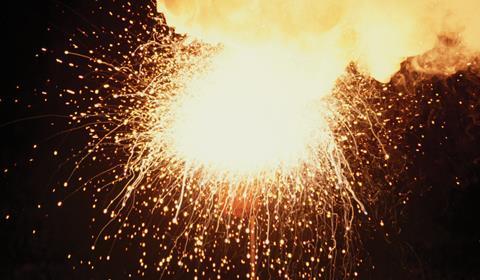Use these tried-and-tested strategies to spark understanding of reactive metals

Displacement reactions are an application of the reactivity series and a step on the journey to learning about redox reactions. You might look at this with 11–14 students or recap it for qualifications at age 16; either way it’s a type of reaction that students will meet again and again in their chemistry education.
This topic tends to concentrate on the reactions of metals with aqueous salt solutions and students always enjoy the practical side of the concept but don’t always retain the core understanding.
The thermite reaction is a fantastic example of how powerful displacement reactions can be
1. Get back to basics
This type of reaction provides a great opportunity to revisit basic ideas about chemical reactions. The reactions can be colourful so changes in colour may be evident in both phases, the metal and the solution. Some are also measurably exothermic. The substances involved provide lots of opportunity for recapping key skills in writing word equations or balancing chemical equations (for younger students) and constructing ionic formulas if your students are older when they’re meeting this topic. Explicitly teach the definition of displacement, remembering that the term has different definitions in maths and physics. Check for recall to support later learning as students will meet examples in other topics, for example in the study of group 7.
2. Study the assessed curriculum
If you are teaching this for a qualification at age 16 then carefully check what the assessment expectations are. Will students have the reactivity series or part of it in a data book or will they need to memorise it? In some qualifications and exam boards, students don’t need to memorise the reactivity series as they will only be asked to construct one from the experimental evidence. Be careful when using assessment items from question databases as older questions might have been designed to be answered together with a data sheet, which may not be the case for the exam your students will take.
Looking for more about displacement reactions?
- Find ideas and strategies for teaching displacement reactions for the 11–14 age group and download the associated classroom-ready activities.
- Watch this video aimed at 14–16 learners.
- Take a microscale approach with this experiment using various metals and metal salt solutions.
3. Zoom in
The core practical activities of observing metals in different aqueous solutions are commonly done in schools. They’re not the most exciting of reactions and can lead to student misbehaviour due to the sheer number of test tubes, metal pieces and solutions needed. They can also be very wasteful when done on a standard scale, generating mixed aqueous metal waste as well as all those small pieces of metal that sometimes end up down the sinks. You can ensure a much more effective learning experience at a reduced scale (for example, on a spotting tile) or even using microscale with a droplet on a laminated sheet. This manages student expectations for something spectacular to happen and focuses their attention on making careful observations.
4. Demonstrate the spectacular
However, displacement reactions aren’t limited to combinations of metals and aqueous metal salt solutions. The thermite reaction is a fantastic example of how powerful displacement reactions can be. If you’re new to this demonstration, it’s worth spending a little time perfecting your accompanying explanations to maximise the learning. There are lots of helpful videos on YouTube showing this demonstration in its real-life use, such as thermite welding of train tracks in remote areas.
5. Check for understanding
For many students, metal displacement reactions are relatively easy, especially if they have a reactivity series chart and don’t need to recall its contents. However, later assessments rarely focus on the familiar contexts and simple recall for easier concepts. Help students to apply their knowledge to unfamiliar examples in the security of the supportive classroom environment. Displacement is used extensively in metal extraction, which can provide some unique contexts for question sets.
Kristy Turner














No comments yet